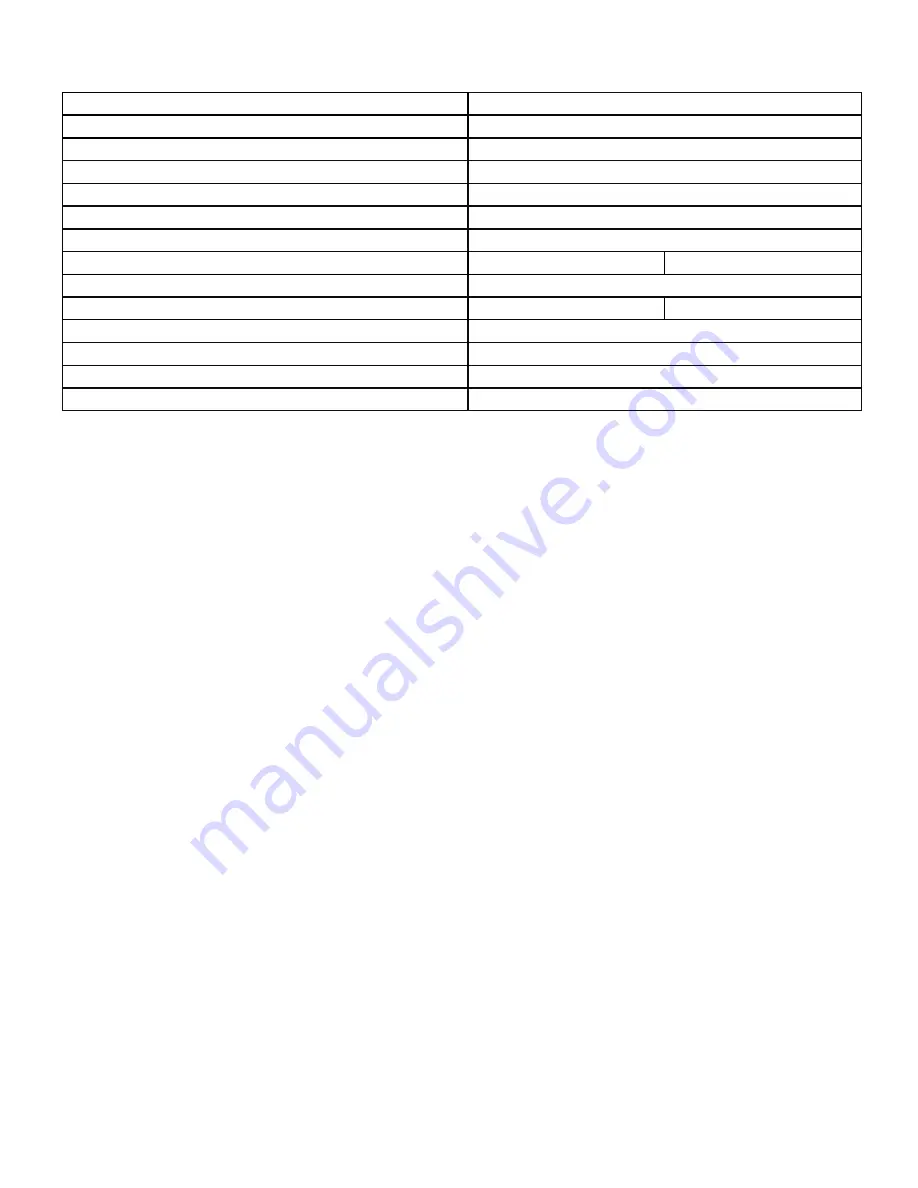
6
2. APPLIANCE PERFORMANCE
(1)
Fuel type
Dry cordwood
Recommended heating area
[*]
1,500 to 3,500 ft² (139 to 325 m²)
Firebox volume
4.9 ft³ (0.139 m³)
Maximum burn time
[*]
17 hours
Maximum input capacity (dry cordwood)
(2)
421,000 BTU
Overall heat output rate (min. to max.)
(3)
19,243 BTU/h to 67,069 BTU/h (5.6 kW to 19.6 kW)
Nominal heat output
at 15lb/ft³ fuel loading density
100,000 BTU/h
Average overall efficiency
(4)
78.9% (HHV)
(5)
85 % (LHV)
(6)
Delivered heat output rate (min. to max.)
(7)
16,109 BTU/h to 54,578 BTU/h (4.7 kW to 16.0 kW)
Average delivered efficiency
(8)
64.8% (HHV)
(5)
70.2% (LHV)
(6)
Optimum efficiency
(9)
85.8%
Average particulate emissions rate
(10)(11)
0.735 lb/mmBTU (0.316 g/MJ)
Average CO
(12)
13.67 lb/mmBTU (5.88 g/MJ)
Average electrical power consumption
(13)
360 Wh
[*]
Recommended heating area and maximum burn time may vary subject to location in home, chimney draft, heat loss factors,
climate, fuel type and other variables. The recommended heating area for a given appliance is defined by the manufacturer as its
capacity to maintain a minimum acceptable temperature considering that the space configuration and the presence of heat
distribution systems have a significant impact in making heat circulation optimum.
(1)
Values are as measured per CSA B415.1-10, except for the recommended heating area, firebox volume, maximum burn time
and maximum input capacity. Performances based on a fuel load prescribed by the standard at 10 lb/ft³ and with moisture
content between 18% and 28%.
(2)
Input value at 10lb/ft³ fuel loading density and dry energy value of 8,600BTU/lb.
(3)
Overall: Radiated and delivered heat together at10lb/ft³ fuel loading density over one total burn cycle.
(4)
Efficiency based on delivered heat when allowing cycling from high to low burn to simulate thermostat demand.
(5)
Higher Heating Value of the fuel.
(6)
Lower Heating Value of the fuel.
(7)
Delivered: Remotely provided to other rooms through ducting at 10 lb/ft³ fuel loading density over one total burn cycle.
(8)
Efficiency based on radiated and delivered heat when allowing cycling from high to low burn to simulate thermostat demand.
(9)
Optimum overall efficiency at a specific burn rate (LHV).
(10)
Based on delivered heat output.
(11)
This appliance is officially tested and certified by an independent agency.
(12)
Carbon Monoxyde. Based on overall heat output at 10lb/ft³ fuel loading density.
(13)
Unless st
ated otherwise, measures were taken directly at the main power source and include all electrical components present in
the appliance.
Содержание MAX CADDY PF01102
Страница 10: ...10...
Страница 47: ...47 15 GENERAL ELECTRICAL DIAGRAM...
Страница 48: ...48 16 ELECTRICAL DIAGRAM FOR PARALLEL FURNACE...
Страница 49: ...49 17 ELECTRICAL DIAGRAM FOR ELECTRIC UNIT...
Страница 55: ...55 22 7 DIFFERENT INSTALLATION...
Страница 61: ...61 26 ELECTRICAL DIAGRAM BECKETT OIL UNIT...
Страница 62: ...62 27 ELECTRICAL DIAGRAM RIELLO OIL UNIT...
Страница 64: ...64 28 4 24V ADDITIONNAL EQUIPMENT 28 5 AIR CONDITIONNING DAMPER 28 6 HUMIDIFIER...
Страница 65: ...65 28 7 HEAT PUMP 29 EXPLODED VIEW AND PART LIST...
Страница 66: ...66...
Страница 67: ...67...
Страница 68: ...68...
Страница 69: ...69...
Страница 70: ...70...
Страница 71: ...71...
Страница 72: ...72...







































